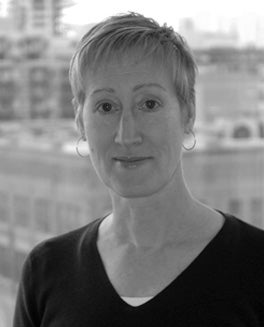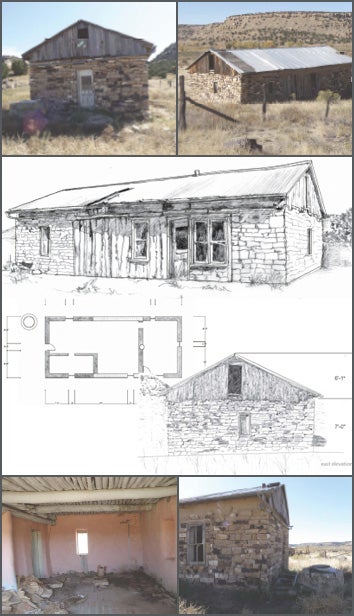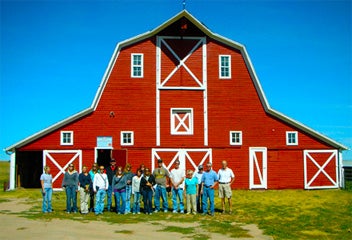Five questions for Kat Vlahos
As a licensed, practicing architect, Kat Vlahos worked on both coasts for a number of years before she decided it was time to come home to her native Colorado. When she returned, she was taken aback by what she saw: an accelerated rate of building without a lot of good decision-making.
“I saw something precious to my heart – the landscape – disappearing, and that was the impetus for me. When I came to the university in 1995, it was because I thought I truly could make a difference,” she says.
Many of the new developments she saw were identical to those she’d seen in parts of the East Coast or even in California. They were missing a sense of place, a concept that always has played a crucial role in her thinking and her design process: understanding an area’s history, evolution, the topography, the climate and the people and how all the components come together. She had earned a bachelor’s degree in environmental design from the University of Colorado Boulder and a master’s in architecture from the University of Colorado Denver; upon her return, she taught a studio and eventually went through the tenure process. She’s now an associate professor at CU Denver in the College of Architecture and Planning and the director of the Center of Preservation Research.
Her research includes vernacular ranch architecture (those structures built without benefit of an architect) and cultural landscapes, which, she says, she finds beautiful and important.
“The everyday, ordinary places have the most to teach us,” she says. “They’re the places that a majority of the population lives in. There’s something pretty incredible about someone going out on the landscape and choosing their spot and building their little cabin. It took a lot of courage to attempt this type of settlement.”
One of her greatest pleasures is driving to rural landscapes, often accompanied by her 8-year-old twin boys, meeting people and watching her sons run and play in the environment she loves.
1. The center works to “preserve the past and examine the present to prepare for the future.” What are some examples of the work you’ve done?
The center has a wide range of faculty involved from several disciplines and colleges. They’re all involved in various aspects of preservation, from the micro level – someone who’s more interested in artifacts – to the larger culture landscapes and interactions between humans and the land. While we are heavily involved regionally, we have a national side and some of faculty work internationally as well.
We’ve come together to push the idea of documentation as something that can be used for informed decision-making, then we go into analysis, representing it, and using it as a tool toward conservation and preservation. We work with government agencies at the local, state and federal levels, and with local conservation groups.
For me, one of the best things we’ve done is work with actual ranching communities that want to sustain a way of life. I’m really proud of our work with Historic Routt County, a nonprofit organization in the Steamboat Springs region. They were a progressive group when we started working with them 10 years ago. We found a way to create a record through writing, drawing and photography so they could use it as a tool to pursue other preservation possibilities. More than 100 ranches have been surveyed and documented, and another community in the southeast part of the state is using the model.
We’ve also worked with the National Park Service and Bureau of Land Management in the Four Corners area, scanning and documenting ancient Anasazi ruins. We used high-tech scanning to make a record of what exists there because, at some point, the ruins will return to the Earth since there’s no plan to stabilize them. We created records that can be used in the future for interpretive or research purposes.
I’m also proud of our work with a number of ranches around the state, including the Buffalo Peaks Ranch and the Hayden Ranch, both owned by the city of Aurora. These sites no longer are involved in traditional ranching and need to evolve into something new, so we worked closely with owners and potential inhabitants to help them discover that evolution. I think the best way to conserve or preserve a place is to continuously use it.
2. Your own research focuses on historic ranches. What motivated you to focus on this area and why is preservation important?
Kat Vlahos has led students on explorations across the state, including this family ranch on the eastern plains.
When I came back to Colorado, what I saw disappearing was the agricultural lands. I come from an agricultural background, and though I left it early in my life, it’s a lifestyle my family has stayed connected to. My cousins continue to ranch; my father was a sheep man who always taught us that our health is directly connected to the health of the land.
I was also concerned by a loss of our heritage in this region. The development seemed insensitive to this region, and I thought a lot of these historic sites understood what needed to happen. I thought if I could analyze some of these old ranch sites, I might learn something about the efficiency and sustainability of materials, of the resources, of the space, even the simplest ideas such as the orientation toward the sun and the wind. These are the very basic concepts that are lost. I thought I could reveal some things about how we should design for this region.
On the most basic level, the American Farmland Trust has a great saying: no farms, no food. I think that a decade ago, a number of my students had never been on a rural site. I could take them to the most basic places, where everything was stripped away and they saw these multi-generational families working the site and really loving what they were doing. There’s something incredible about exposing my students to these places. They learned a lot from talking to people who live close to the land, and also the whole notion of developing sustainable practices, which now, thank goodness, has come to the forefront of our awareness.
These people are stewards of the land. The buildings teach us basic ways about thinking about our built environment – the materials, the resources, the interaction of buildings and land, and the culture and traditions and values of the people. Preservation is important because all of these speak to what makes this American West an interesting place.
3. What would you consider one of the center’s crowning achievements to date?
Through the support of our dean we were able to acquire some high-tech LIDAR laser scanners. One of the biggest challenges for me has been the scale of these landscapes. The high-tech equipment has put us on the cutting edge and given us another tool to be able to get out into the fields and create an incredibly accurate record of the place.
4. What kinds of criteria do you use to determine the projects the center will take on?
We are doing applied research, so you have to be careful when you’re involved in the field that you don’t become a tool for people to use. We are heavily connected to research and are committed to making better places by looking at information that can guide that process. Typically, communities or agencies will approach us and, as a group, we’ll discuss if the project provides an educational component for our grad students and what it brings to faculty research. And we look at the benefits to the public and the university.
There’s also a grassroots approach. Ranches happen to be my passion, so I’ll push them as a project. Another faculty member is interested in Civilian Conservation Corps projects. The center tries to provide a supportive environment for faculty to explore their interests and educate students and to give something back to the community.
5. Are you still designing?
I design through my students now. The university system has a one-sixth rule that says faculty are required to restrict outside work and consulting to one-sixth of their time. But the work I do is very time- and energy-consuming, and having an outside practice would take away from that. I couldn’t serve both well. I have found a way to practice with my students: All the projects we work on use real places and real people trying to resolve and solve real problems. You want to be able to integrate your life into the work you are doing. For me personally, the center and the college, and my ranches and my kids all have somehow become woven together. That works for me in a way that brings me a lot of joy.




